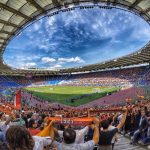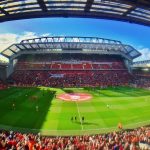Even though it’s not the biggest stadium in Germany, I think it’s definitely the most impressive one.
The Allianz Arena in Munich breathes football and is the home venue of one of the most successful football clubs in the world.
The interior of this magnificent arena has 3 tiers that are very close to the playing field and the exterior features plastic panels that can be illuminated.
Let’s take a closer look at some of the most interesting facts about the Allianz Arena so you can learn about this fantastic stadium in Europe.
1. It’s located in northern Munich and stands next to the city’s oldest church
The Allianz Arena is the home stadium of the most successful German football club in history, FC Bayern Munich.
Munich is the capital city of the Bavaria region in the southern part of Germany and the third-most populous city in the country.
This is Germany so everything was meticulously planned before construction started. The Munich Airport is just a short drive away on the northern outskirts of the city.
The stadium is also easy to reach with public transportation as the Fröttmaning U-Bahn station is located just south of the station, allowing you to easily reach from any part of Munich.
The oldest church in the city, known as the “Holy Cross Church,” is located right next to it. This small church has a history that dates back to before 815, the year it was first mentioned.

2. It’s the home of FC Bayern Munich but another local team initially used it
Today, the only tenant of the stadium is FC Bayern Munich, but this wasn’t always the case. Initially, the Allianz Arena was constructed as the venue of another local team as well.
1860 Munich had 50% ownership of the stadium when it first opened for the 2005-2006 season. Their bigger rivals purchased their shares for €11 million shortly after in April 2006.
The financially struggling football club was initially allowed to play at the stadium until 2025 but Bayern terminated this contract in 2017.

3. It replaced the Olympiastadion which was constructed for the 1972 Summer Olympics
Both clubs had a history of sharing the same stadium that went back to the mid-1920s. The Grünwalder Stadion was constructed by 1860 Munich in 1911 and became Bayern’s home in 1926.
The smaller club from Munich owned the stadium until World War II but it was partially destroyed during this devastating event.
The outdated stadium was replaced by the Olympiastadion, not to be confused with the Olympiastadion in Berlin, which was constructed between 1968 and 1972.
This amazing stadium can still seat 69,250 people but is mainly used for athletics events and concerts today.
What about 1860 Munich, you wonder? They play their home games in the lower tiers of the German football league system in their original home, the Grünwalder Stadion, once again.

4. The exterior features 2,874 ETFE plastic panels and looks amazing at night
The interior of the Allianz Arena is amazing but the most remarkable feature of this stunning football stadium is the exterior.
It’s completely covered with 2,874 ETFE plastic panels that are kept inflated with dry air. These can be illuminated at night to produce an amazing effect.
Although the stadium can theoretically produce any type of color scheme imaginable, the police intervened and strongly suggested the stadium operators only use a single light scheme.
That’s because the stadium is located right next to the city’s outer ring road and using multiple lights can distract drivers resulting in car accidents.

5. The stadium was expanded twice and is now the 5th-largest stadium in Europe
The Allianz Arena is not only one of the most amazing stadiums in Germany, but it’s also one of the biggest stadiums in Europe.
It initially had a seating capacity of 66,000 which was quickly expanded to 69,000 with the addition of standing spaces.
New seats were added to the upper tiers twice, once in 2012 and another time in 2014. This brought the current capacity to 70,000 for international games and 75,024 for Bundesliga games.
This makes the Allianz Aena the 5th-largest stadium in Europe in terms of capacity and one of the most amazing places to watch a game of football in the world.

More interesting facts about the Allianz Arena in Munich
6. The stadium cost €340 million to build and Bayern Munich declared that the Allianz Arena was fully paid off in 2014. This just shows how healthy and successful the club is financially.
7. The stadium owned by the most successful football club in Germany is the second-largest stadium in Germany. The biggest stadium is owned by the second-most successful football club in Germany, the Westfalenstadion of Borussia Dortmund.

8. The stadium is named after the German financial service company that bought the naming rights. Allianz is a shareholder of FC Bayern München AG and acquired these rights for a duration of 30 years. The contract will end in 2041.
9. There’s a caveat when it comes to the naming rights of the stadium. Allianz can only smear its logo on the stadium’s exterior during Bundesliga games. During UEFA and FIFA games, the stadium is logo-free and referred to as the “Fußball Arena München.”

10. Building the stadium took nearly 3 years between 2002 and 2005. The first stone was laid on October 21, 2002, and the stadium was officially inaugurated on May 30, 2005.
11. The arena was constructed during 120,000 cubic meters (42.37 million cubic feet) of concrete and 22,000 tonnes of steel. It’s also equipped with the largest underground parking garage in Europe for which 85,000 cubic meters (3 million cubic feet) of concrete and 14,000 tonnes of steel were used.

12. The exterior of the arena is remarkable and is worth a closer look. When you look at the 2,874 plastic panels from a distance they appear to be white. When you come a bit closer, they actually consist of little white dots.
These panels are only 0.2 millimeters (0.00078 inches) in thickness which means you can see through them when you’re close enough.













